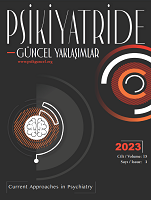Comparative Examination of ICD-11 and DSM-5 Alternative Model in Personality Disorders
Comparative Examination of ICD-11 and DSM-5 Alternative Model in Personality Disorders
Author(s): Türkmen TöreSubject(s): Comparative Psychology, Personality Psychology, Clinical psychology, Behaviorism
Published by: Çukurova Universitesi Tip Fakultesi Psikiyatri Anabilim Dalı
Keywords: Personality disorders; personality; psychiatric diagnosis; mental disorder;
Summary/Abstract: Personality disorders tried to be explained by changing diagnoses and approaches varying from school to school throughout history. With the updated approaches and scientific developments in today's diagnostic booklets, developing and more understandable diagnostic categories for personality disorders are created. New models can be an important resource for diagnosis, treatment and common language among clinicians. Both ICD-11 and DSM5 main part section III. have highlighted new models beyond the previous personality disorders diagnostic approach. In both models, personality disorders are examined according to severity levels and prominent personality features model. Moreover, personality disorder includes structures that take into account the course of basic personality traits such as self, identity and bilateral relations. While DSM-5 part III. Alternative model on personality disorders section has a content of 5 prominent features, 25 sub-features and functionality which are all for evaluating the disorder, the ICD-11 model includes an approach that includes five features and borderline pattern and definitions, and a 4-dimensional structure in which functionality is evaluated. Although both models include models of features that stand out in personality but not completely overlap with each other. For example, while Psychoticism finds its place as a personality trait in alternative model in section III of DSM-5, as it is not accepted in personality feature in ICD-11. In contrast, the borderline pattern is not named as a feature in DSM-5 in section III, but the ICD-11 treats the borderline pattern as a kind of feature. This is one of the important differences between the two guidelines. Similarly, the criteria by which functionality and impairment are evaluated are not compatible with each other and do not progress in parallel. This means that two different guidelines accept different severity levels as thresholds. However, it can be said that both models accept the personality disorders approach, which includes longitudinal processes in which personality traits can be seen instead of categorical models. The differences between the new models can be interpreted as an obstacle to the development of a common language in terms of diagnosis and treatment.
Journal: Psikiyatride Güncel Yaklaşımlar
- Issue Year: 15/2023
- Issue No: 1
- Page Range: 189-202
- Page Count: 14
- Language: English

